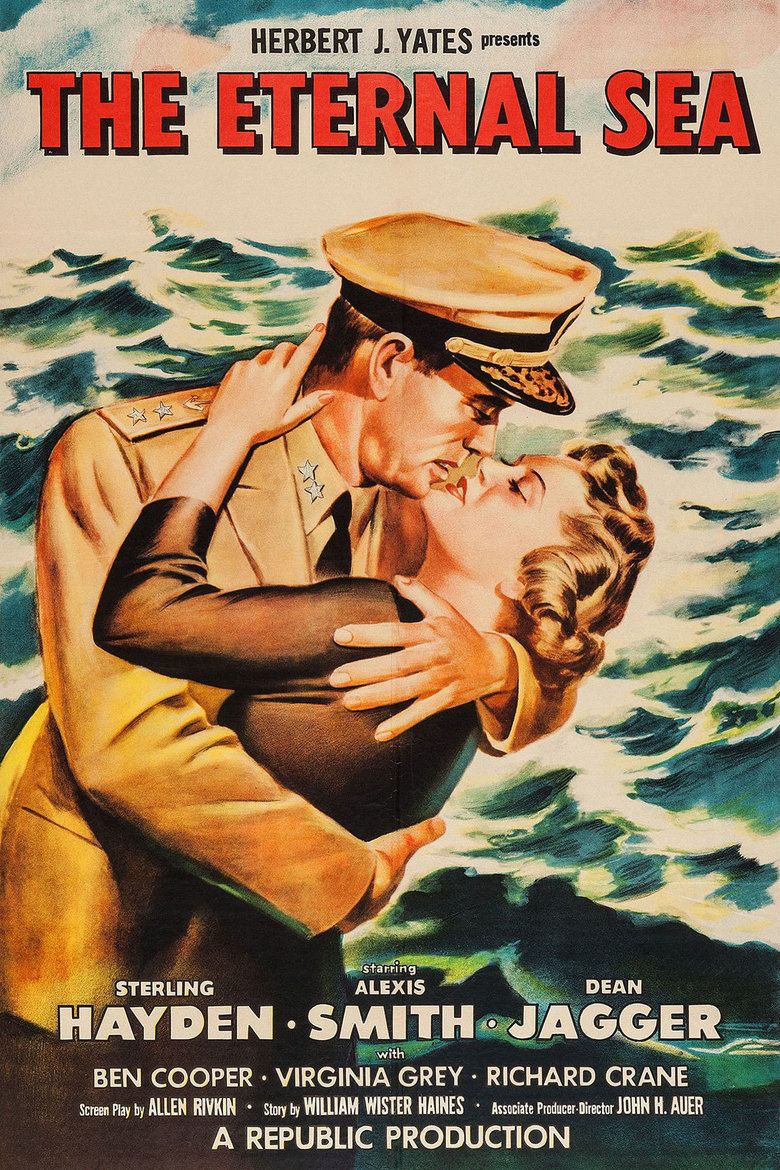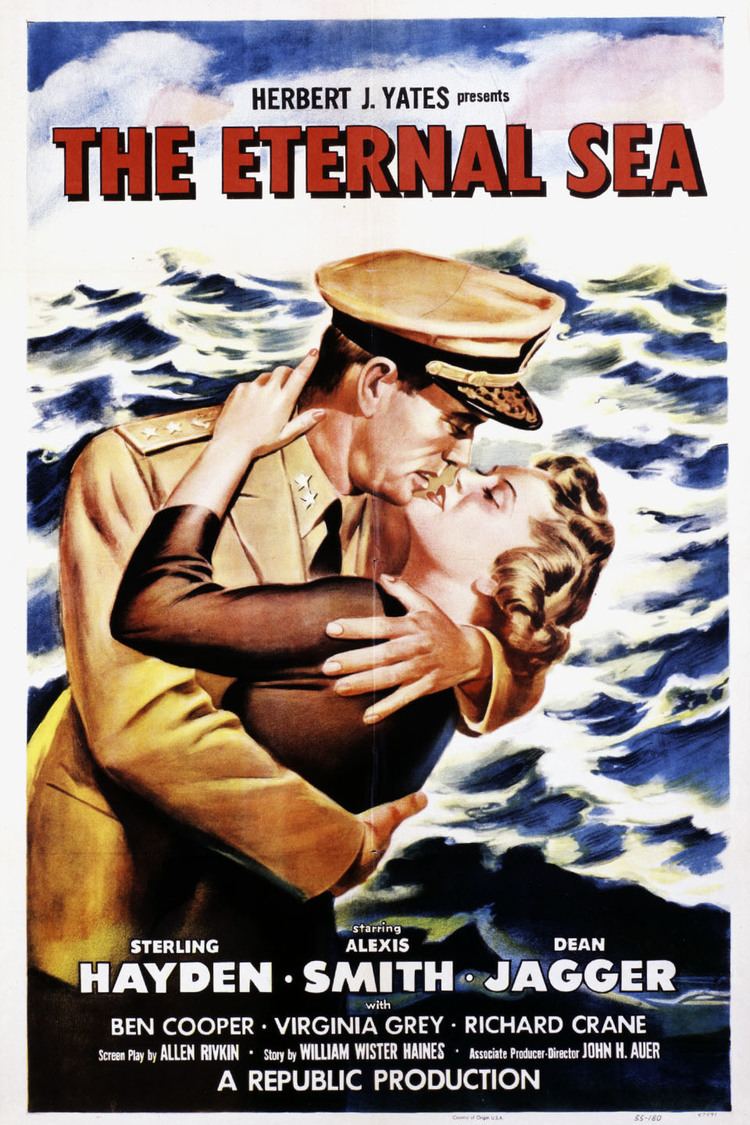The Eternal Sea
6.6 /10 1 Votes6.6
Duration Country United States | 6.6/10 IMDb Genre War, Drama Language English | |||||||||||||||||||||||||||||||||
 | ||||||||||||||||||||||||||||||||||
Release date May 5, 1955 Cast (Rear-Adm. John Madison Hoskins), (Sue Hoskins), (Seaman P.J. 'Zuggy' Zugbaum), (Vice-Adm. Thomas L. Semple), (Dorothy Buracker), (Capt. William Buracker) Similar movies Wake Island , The Thin Red Line , When Trumpets Fade , Hell Is for Heroes , None But the Brave , Farewell to the King | ||||||||||||||||||||||||||||||||||
Orchestral suite the eternal sea ost 1955
The Eternal Sea (aka The Admiral Hoskins Story) is a 1955 American war film directed by John H. Auer and starring Sterling Hayden, Alexis Smith and Ben Cooper. After an American naval officer loses his leg at the Battle of Leyte Gulf, he resists attempts to retire him and continues in the service after learning to cope with his disability. He goes on to be promoted to admiral and commands an aircraft carrier during the Korean War.
Contents
- Orchestral suite the eternal sea ost 1955
- The eternal sea 1955 elmer bernstein
- Plot
- Production
- Reception
- Frost the eternal sea
- References

The Eternal Sea was one of a number of more ambitious productions by Republic Pictures, which had traditionally made low-budget second features. Its release was undermined by the studio's growing financial problems which led to its eventual closure in 1959.
The eternal sea 1955 elmer bernstein
Plot
In World War II, newly promoted Capt. John Madison Hoskins (Sterling Hayden) returns home after two years at sea to spend a seven-hour leave with his wife Sue (Alexis Smith) and their children, before taking command of the ship USS Hornet (CV-8) but the ship has been sunk. Hoskins is then reassigned as an instructor at Quonset Point, Rhode Island, much closer to home but "... thousands of miles from the only war he'll get to fight in."
Two years later after teaching some of the US Navy's top students, Hoskins is given command of the USS Princeton (CVL-23) but its present commander, Capt. William Buracker (Hayden Rorke) is retained for the Philippine campaign, During the attack, the ship is crippled and Buracker orders her sunk. Hoskins, severely wounded, his foot is amputated to save his life.
Later, at a naval hospital in Philadelphia, Hoskins meets "Zuggy" (Ben Cooper), another amputee who lost an arm and is being honorably discharged. His disability makes Hoskins eligible for retirement and promotion to rear admiral but he pushes himself to be ready to take over the new USS Princeton being built in the nearby Navy shipyard. With encouragement from Sue, Vice-Adm. Thomas L. Semple (Dean Jagger) reveals that by a navy code, no disabled officer can be compelled to retire.
After long periods of walks and climbing the new ship, Hoskins falls from the scaffolding. Although injured, he comes into his review meeting without crutches, convincing the tribunal that he is fit to serve. The next day, at the launching of the USS Princeton (CV-37), Hoskins is assigned as its commander.
After the war, Hoskins advocates for the use of jet aircraft off aircraft carriers and when he is transferred to San Diego, he is able to demonstrate the capabilities of jets to land on carrier ships. Despite one jet crashing due to mechanical failure, the US Navy is convinced of the viability of jet operations.
Assigned to the carrier division for aircraft operation at sea, Hoskins joins Adm. Arthur Dewey Struble (Morris Ankrum) of the 7th Fleet. Flying the lead aircraft, Hoskins demonstrates that jets can be used safely on aircraft carriers, in time to be effective in Korea.
After celebrating a wedding anniversary with Sue, Hoskins is offered the choice of two important jobs that would further his career, but take him away from active duty. Discouraged by the prospect, when he witnesses the return of wounded men by the Air Transport Service from the Korean front, Hoskins is inspired to show the injured men that they can still lead an active life and turns down both jobs, asking instead to be put in charge of the Pacific Division of the Air Transport Service.
Production
Among other locations, The Eternal Sea was filmed from October 7 to late October, 1954, at the USS Kearsarge (CV-33) while on a "Show The Flag" cruise around Asia. Support from the US Navy was also in the form of the loan of Douglas AD-1 Skyraider, Grumman F9F Panther aircraft and Piasecki HUP-2 Retriever helicopter. Other aircraft that were seen, include Korean wounded disembarking from MATS aircraft, a Douglas C-54 Skymaster and a Boeing C-97 Stratofreighter. Use of documentary film from World War II was also evident.
Reception
The Eternal Sea was an attempt by Republic Pictures studio head Herbert J. Yates to add a high quality production to the usual output of low budget features. The studio promotion "breathlessly" highlighted: "Hollywood Now Brings You a Story of Heroic Greatness...; Inspired by the depths of a woman's love! and The real-life Naval Hero who defied disaster - to soar his jet to glory!"
With production costs increasing, Yates organized Republic's output into four types of films: "Jubilee", usually a western shot in seven days for about $50,000; "Anniversary", filmed in 14 to 15 days for $175,000 to $200,000; "Deluxe", major productions made with a budget of around $500,000; and "Premiere", which were usually made by top-rank directors who did not usually work for Republic, such as John Ford, Fritz Lang and Frank Borzage, and which could have a budget of $1,000,000 or more.Some of these "Deluxe" films were from independent production companies that were picked up for release by Republic.
Frost the eternal sea
References
The Eternal Sea WikipediaThe Eternal Sea IMDbThe Eternal Sea themoviedb.org
